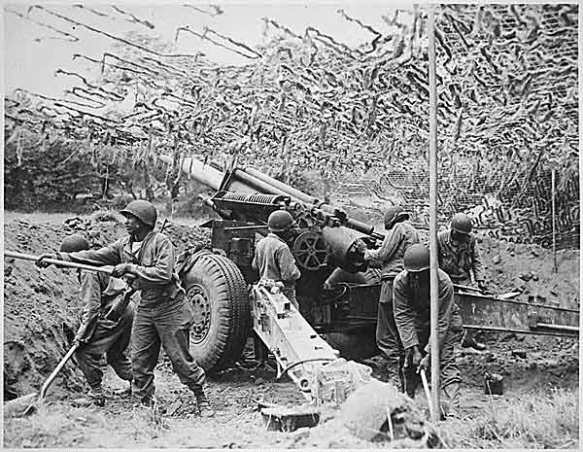A U. S. Army 155-mm Howitzer M1 battery prepares for a firing mission in this post-World War II picture. Prior to a firing mission the crew of an M1 lowered a firing jack (pedestal) located under the center axle of the weapon. Once this device was in place, the two wheels were raised. This resulted in a three-point support system for the gun, one point of contact being the firing jack and the other two points being the spades of the trail. This arrangement improved both the stability of the weapon and its accuracy.
In recommending the development of a new 105-mm light howitzer for divisional use, the Westervelt Board had discounted the need for a divisional 155-mm medium support howitzer. The French Schneider 155-mm M1917 medium howitzer and its postwar American copy, the M1918, had proven unpopular during World War I, due to their heavy weight and resulting poor mobility.
After World War I, General John J. Pershing and others blamed the large-scale use of artillery for the static positional warfare that had developed in Western Europe. To prevent a recurrence, Pershing suggested that the army be organized into smaller, highly mobile divisions with tanks and machine guns. Artillery support was to be provided by guns or howitzers with a caliber of 75-mm or smaller.
The army studied the Westervelt Board and the Pershing recommendations and decided to reinstate the 155-mm howitzer in its infantry divisions in 1929. During the 1920s and 1930s the army began a modernization program for its aging M1917 and M1918 medium 155-mm howitzers to allow high-speed towing by trucks. Simultaneously, Brigadier General Lesley J. McNair began to suggest that the army had placed too much importance on artillery in close support of the infantry. He believed that modern long-range artillery pieces massing their fire together on important targets could be supremely effective on the battlefields of the future. McNair therefore urged that the army’s infantry divisions reduce the number of light guns and howitzers and increase the number of medium howitzers.
Field tests conducted by the army in 1937 had again confirmed McNair’s belief that the 155-mm howitzer, M1917 and M1918, was still superior to the new prototype 105-mm M2 howitzer, due to its ability to deliver more bang for the buck.
Additional tests in 1938 and information on foreign medium artillery development further pointed to the need for a 155-mm medium howitzer in its infantry divisional structure. A few days after the French-German armistice in June 1940, the army adopted a new infantry division structure with four artillery battalions; three direct support battalions of 105-mm howitzer (54 pieces) and one general support battalion of 155-mm howitzers (12 pieces).
The Ordnance Department had begun work in 1939 on a replacement for the aging M1917 and M1918 155-mm howitzer. That replacement arrived as the M1 155-mm howitzer in early 1942. It featured a new longer barrel as well as a new carriage.
The M1 155-mm howitzer was often referred to by American cannoneers as “the sweetest weapon on the front” due to its outstanding accuracy. By the end of the war American factories had built over 6,000 of the howitzers. They would see heavy use with Patton’s troops from July 1944 until the war ended in Europe. The older M1917 and M1918 155-mm howitzers would soldier on until 1943, when enough of the new M1 155-mm howitzers reached artillery units in the field. American artillerymen affectionately referred to the old M1917 and M1918 howitzers “as faithful old dogs.”
155mm Howitzer M1 (M114). The Howitzer M1 was upgraded after World War II as the M114 and was widely exported. Mounted on a split trail carriage, it was served by a crew of eleven and capable of a sustained firing rate of 40 rounds per hour.
155mm Howitzer M1 (M114)
Adoption date: 1941
Caliber: 155mm
Weight: 12,700 pounds
Breech: interrupted screw
Barrel length: 149 inches
Elevation: 65°
Traversal: 50°
Projectile weight: 95 pounds
Muzzle velocity: 2,089 fps
Maximum range: 15,966 yards
